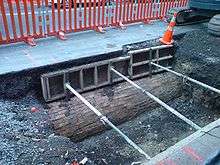Waihorotiu Stream
Waihorotiu (from the Māori Wai Horotiu), sometimes called the Waihorotiu Stream and the 'Queen Street River', is a stream that ran down the Queen Street gully in the Auckland CBD, New Zealand, into the Waitemata Harbour. It has long since been covered over and put underground by the urbanisation of the area.

History
Originally this was an open stream that was one of the tributaries of the Waitemata River, now submerged by rising sea levels in the Waitematā Harbour. The Waihorotiu carved out the Queen Street valley millions of years ago. The upper part of that valley now forms Myers Park. The references to a spring feeding the stream in the area of the Baptist Tabernacle in Myers Park are problematic (no historical document references this and if a spring existed it is unlikely it would have been built over).[1] The stream ran through a swampy area (now Aotea Square) and then northwards between Queen and Elliot Streets until the vicinity of Victoria Street, where, emerging behind the Courthouse, it flowed down into what is now the lower part of Queen Street. It entered the harbour at what is now called Fort Street but in the early colonial period was called Fore Street, a shortened form of Foreshore. The lower reaches of the stream above the Fort Street will have been tidal; doubtless pre-European Maori fished in this area.
The swampy area now occupied by Aotea Square was probably used to trap birds and possibly eels. A side tributary (occupying the gully between Wellesley and Airedale Streets) possibly provided drinking water for both Maori villages and the first European colonists of Auckland, although the still existing Spring just to the north of Waterloo Quadrant (later utilised by the Grey & Menzies Mineral Water Company) may have been perferred as more reliable.[2][3] The stream flowed into Horotiu Bay (called Commercial Bay after European settlement).[1] In Maori mythology, the stream is the home of Horotiu, a taniwha (roughly speaking, a local nature spirit).[4]
Initially European settlement of the central area tended to be on the Shortland Street rise and the Albert Park Hill area. However, as the population grew the Queen Street valley began to fill up with buildings, partly due to a big fire in the Shortland Street area.[3] An open stream in the centre of the road created problems especially in a period before any sewerage system was in operation. The sides of the stream crumbled in wet weather and there were only a few place to cross (sometimes just plank walkways). Periodically people and carriages tumbled into what had become little more than an open sewer.
Around the middle of the century the Surveyor General Charles Ligar attempted to regulate the stream by building sound walls to constrict its waters (this was referred to as the Ligar Canal).[5] This proved inadequate (being called "an abomination, a pestiferous ditch, and the receptacle of every imaginable filth")[3] and eventually the stream was bricked over in the form of a sewer - water percolating through the soil under Myers Park still runs into the old drain under Queen Street to the sea, discharging under the Ferry Building.
In 2011, a local artist proposed that, as part of the Council's city centre masterplan, the stream be uncovered and become a centrepiece of a more people-friendly inner city.[6]
References
- Stream Daylighting - Identifying Opportunities for Central Auckland - part 2 (PDF). Auckland Regional Council. 2008. Retrieved 31 May 2016.
- Britomart location and heritage (Britomart Project History, Auckland City Council website. Retrieved 2007-12-01)
- "Ligar canal long forgotten". Auckland's City Scene magazine, Sunday 25 June 2006 (originally from The New Zealand Herald, approximately 1870)
- Bull, Alastair (9 June 2011). "Taniwha debate raises valid point". The New Zealand Herald. Retrieved 9 June 2011.
- Auckland WaterPark - Bradbury, Matthew; abstract, The Landscape Architect, IFLA Conference Papers, May 2006
- Orsman, Bernard (9 May 2011). "Artist paints downtown garden vision". The New Zealand Herald. Retrieved 11 May 2011.
External links
- From stream to sewer (from the Auckland City Council website)
- Waihorotiu - A Short Documentary (A short film on the Waihorotiu Stream)
- Photographs of Ligar Canal held in Auckland Libraries' heritage collections.
- Auckland, I love you A zine about Waihorotiu.